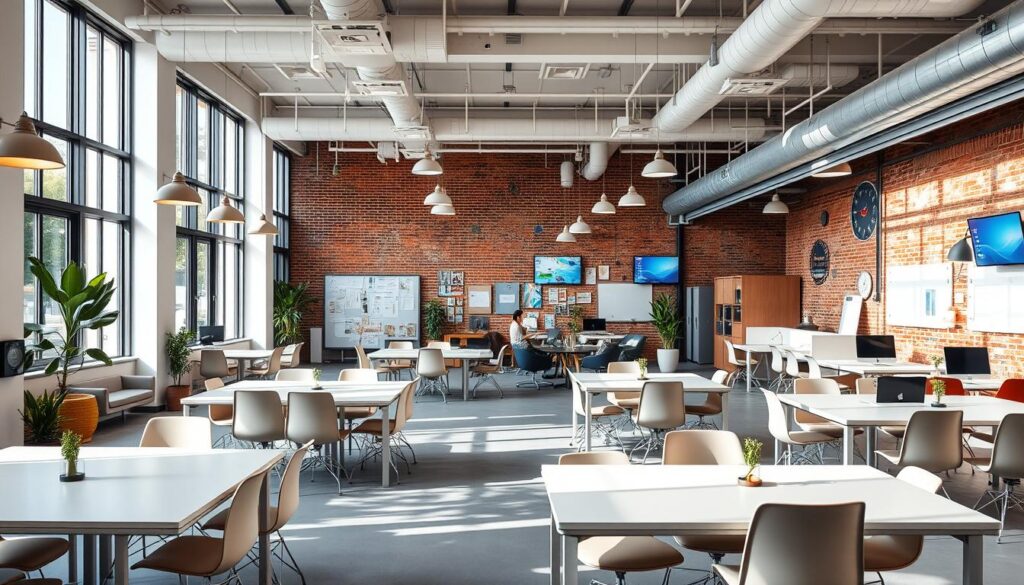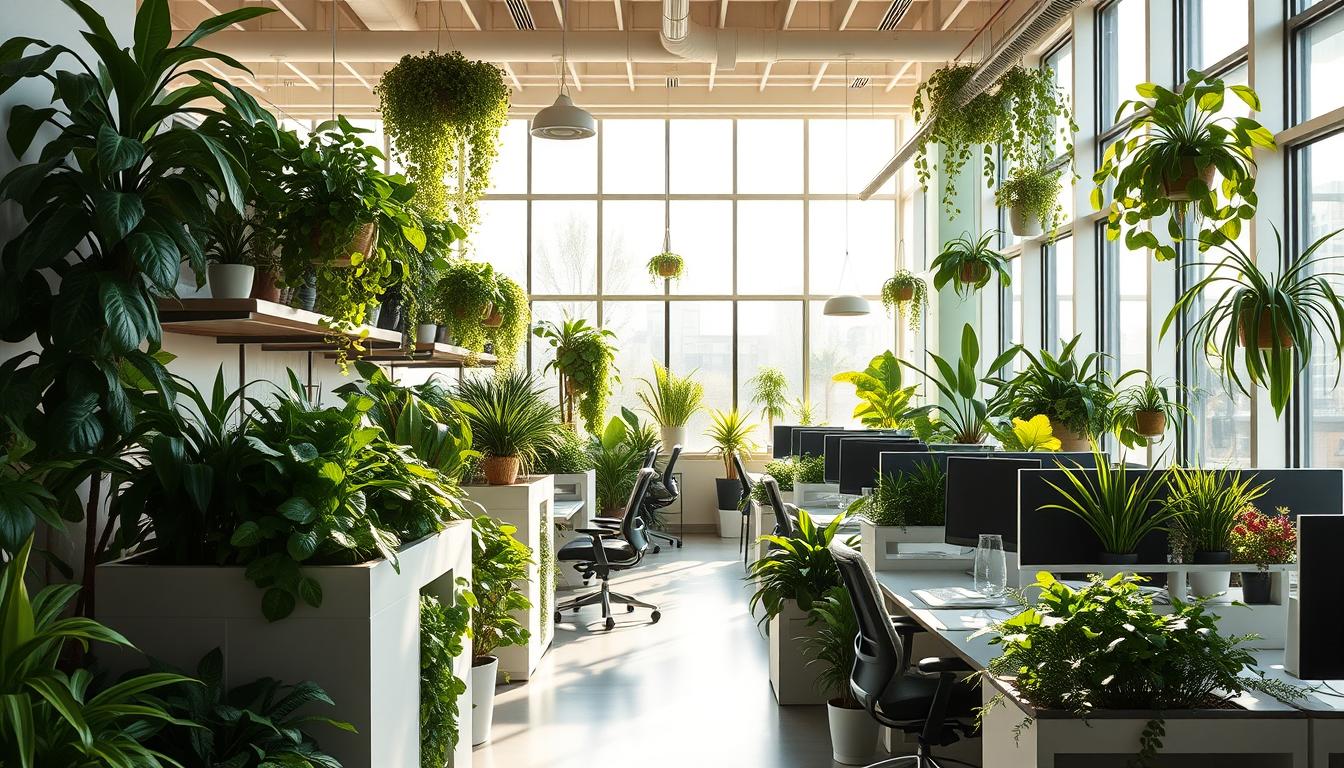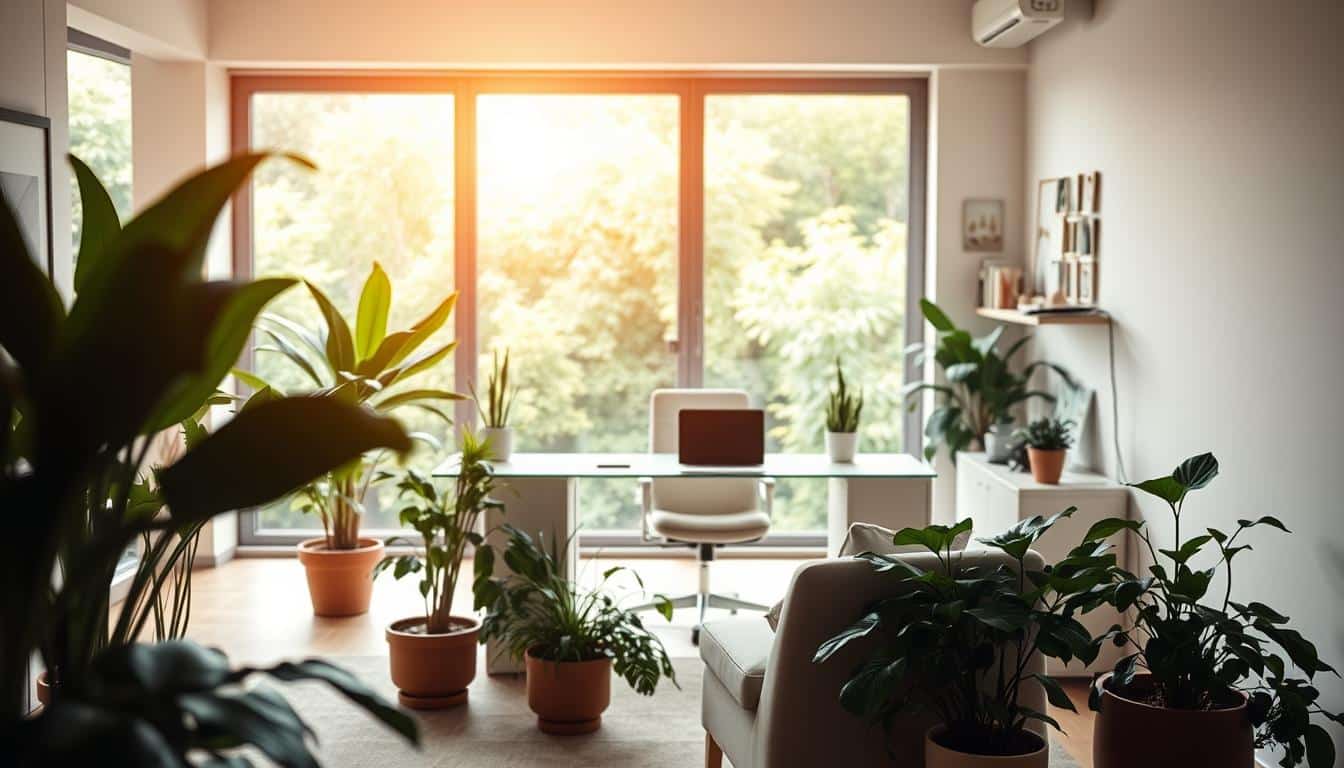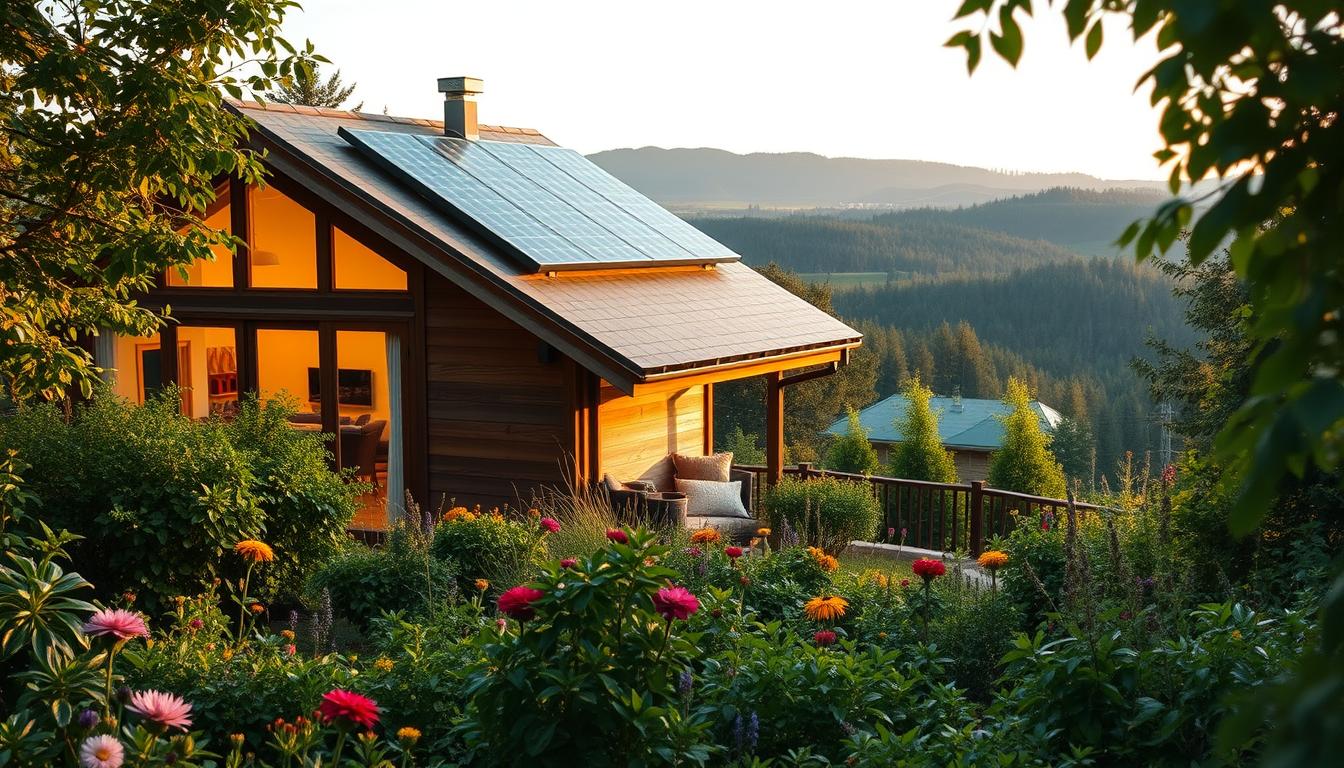The growth of coworking hubs highlights the importance of microclimate variability. It affects both productivity and comfort in shared spaces. As tech, community, and real estate mix, understanding these microclimates becomes key to creating innovative workplaces. This study seeks to pinpoint research gaps and explain how microclimate variability impacts worker performance. It aims to guide future coworking space design and functionality.
Introduction to Coworking Spaces
Since 2005, coworking spaces have changed how we see workspaces. Born in San Francisco, they bring freelancers, startups, and big companies together. In these spaces, people share work areas which sparks new ideas and teamwork. The design makes people more productive and creates a community feeling among different professionals.
These spaces are loved for being flexible. Companies find it easy to grow or cut down their size in these areas, saving money. This flexibility also makes it easier for people to balance work and life. As more people want such workspaces, the world will see more coworking areas. This changes the way we think about work places.

The Importance of Microclimate in Work Environments
Microclimate is very important in making workspaces better and helping workers be more productive. Things like temperature, humidity, air quality, and how much natural light there is all play a part. Knowing about these things can help in creating work areas that are comfortable and help people work well. This makes a big difference in how well employees do their jobs.
Understanding Microclimate Variables
When we talk about microclimate, we’re talking about different factors that are key in workspaces. These include:
- Temperature: Having the right warmth or coolness is key for comfort.
- Humidity: The right moisture levels keep things comfortable and healthy.
- Air Quality: Clean air means a healthier place to work, with less pollution.
- Natural Light: Seeing natural light is good for mood and focus.
Understanding microclimate means we can make workspaces that fit different needs. This leads to happier and more engaged workers.
Impact of Microclimate on Worker Performance
Studies show that good microclimates help with thinking skills, which makes workers more productive. In good work settings, employees often:
- Have better focus and more creativity.
- Feel happier with their jobs and more driven.
- Work better together and communicate well with others.
Paying attention to microclimate and improving it can help businesses make better workspaces. This boosts what workers can achieve.
Microclimate Variability in Coworking Hubs
The climate inside coworking spaces is very important. It changes because of the weather outside and how the indoor space is managed. As coworking becomes more popular, it’s key to understand these changes. This ensures everyone is happy and works well.
Here’s how the climate inside these places can change things:
- Changes in temperature can make it hard to focus and work well.
- The level of moisture in the air affects health and how well people work.
- The kind of light there is can make people feel more or less creative.
People working in these spaces do better when the climate is managed just right. Tackling these climate changes means coworking spaces can be great places to work together, be creative, and feel good. Looking at the climate closely helps keep everyone content and wanting to stay, even as workspace needs change quickly.
Characteristics of Successful Coworking Hubs
Successful coworking hubs boost community and engagement. They have a lively vibe that encourages working together. This increases work done and new ideas.
These places change to meet different needs. They’re perfect for today’s varied work styles.
Community and Collaboration
At the heart of top coworking spaces is a strong community. This community offers chances to network and share. It makes people feel like they belong.
This sense of team spirit boosts creativity. It helps everyone grow personally and professionally. Ideas are shared freely, leading to special projects.
Flexibility and Adaptability of Space
Being able to change the workspace setup is key in our busy world. Top coworking spaces have many types of areas. People can pick what works best for them.
Whether someone needs quiet to focus or a place to share ideas, these hubs have it. This helps all kinds of workers be more efficient.
The Role of Biophilic Design in Coworking Spaces
Adding biophilic design to coworking spaces offers great benefits. It makes workers feel better and think more clearly. With plants, sunlight, and water features, these places become healthier and workers do better.
Natural Elements and Worker Well-being
Natural features in coworking spaces really help workers feel good. Being around plants makes people more relaxed and mentally healthy. Natural light boosts mood and energy, making people more motivated and happy with their jobs.
Cognitive Performance in Enhanced Environments
Studies show that biophilic design improves how we think and perform at work. Coworking spaces with these designs boost creativity and problem-solving. They make workspaces where people feel good and do well. This makes adding natural elements very important.
Environmental Adaptation in Coworking Spaces
Understanding environmental adaptation is key for effective coworking spaces. Good indoor air quality and temperature control matter a lot for comfort and productivity. Coworking spaces must be quick to adjust to environmental changes. This ensures the health and happiness of everyone using the space.
Effects of Indoor Air Quality
Indoor air quality is very important for health and comfort in coworking spaces. Bad air can harm health and lower how well people work. Coworking spaces fight this with better ventilation, air purifiers, and checking the systems often. This creates a workplace that’s healthier, with clean oxygen and fewer allergens or pollutants.
Adjusting to Temperature and Humidity
Managing temperature and humidity is critical in shared work areas. When the temperature changes a lot, it’s hard to focus and be productive. Many coworking spaces now use smart technology. This tech monitors and changes the environment as needed. It keeps the temperature steady and humidity just right, making a great place for working together and being creative.
Factors Influencing Coworking Hub Microclimates
The microclimates in coworking spaces depend on key factors. Knowing these factors can greatly improve the workspace feeling. The design of the space is important for airflow and light spread. Natural light helps people work better, and good airflow makes it easier for them to work together.
The materials used for building and furniture affect the microclimate too. Using green and sustainable materials helps the air inside, which is good for people’s health and comfort. Things like heating, cooling, and air systems control the temperature and moisture. These aspects change how comfy and useful a coworking space is for everyone.
In short, to make a coworking space work well, you need to think about microclimate factors carefully. From the way it’s set up to the materials and temperature control, everything matters. All these parts help make the space better for people to work in.
Employee Satisfaction and Comfort in Coworking Environments
To create a winning coworking space, focus on making employees happy and comfy. Workers often say they want spaces that are both useful and fun. It’s all about knowing what people want in their workspace.
Feedback from Coworking Users
Comfort is key for people in coworking spaces, they tell us. They often mention:
- Ergonomic furniture that supports long hours of work without causing fatigue.
- Common areas designed for collaboration, fostering a sense of community.
- Aesthetic appeal, including natural light and greenery, which enhances productivity and mood.
Design Trends in Modern Coworking Spaces
Today’s design trends aim to boost employee happiness. Highlights include:
- Incorporation of flexible workspaces that can be rearranged according to team needs.
- Development of wellness spaces, such as relaxation areas and fitness facilities.
- Utilization of high-quality materials that create a polished and inviting look.
Methodology for Analyzing Microclimate Variability
Studying microclimate changes in coworking spaces needs a strong method for analyzing them. This includes collecting data in various ways. These methods help get true info on the environment. Using good tools for measurement is key to get trustworthy data.
Data Collection Techniques
To fully understand microclimate, we must use good data collection methods. Techniques often used include:
- Surveys to know what people think about comfort and if they’re happy
- Sensors that check temperature, humidity, and air cleanliness
- Watching how spaces are used and how people act
Tools for Measuring Indoor Microclimate
Choosing the right tools is vital for correct data. Different advanced tools help get exact measures of indoor climate factors, like:
- Digital hygrometers for checking moisture in the air
- Thermometers for exact temperature info
- Air quality monitors for air pollution level checks
Case Studies of Microclimate Impact on Coworking Hubs
Studies show microclimate plays a big role in coworking spaces. Different settings prove temperature, humidity, and air affect how well people work and feel.
One coworking hub saw more creativity and teamwork after improving their air. By using better ventilation and plants, they made their space’s climate better.
However, another space struggled with bad temperature control. This made the place uncomfortable and lowered team spirit. They found fixing climate issues kept people happy and staying longer.
Learning from these examples shows that designing coworking spaces should focus on the climate. With good planning, coworking areas can be great for coming up with new ideas and working better.
Future Trends in Coworking Hub Design
Coworking spaces are becoming more popular. Design trends are evolving to make these places innovative workspaces. They’re including tech to boost productivity and help people connect better, meeting modern workers’ needs.
Being eco-friendly is also important. More coworking spaces use green materials and save energy. This approach lowers environmental harm and draws people who value sustainability.
Another trend is focusing on health. Good air flow, more natural light, and outside areas are being added. As people care more about staying healthy, these changes are shaping the future of workspaces.
- Smart technology integration for seamless connectivity
- Sustainable materials and construction practices
- Health-focused amenities for improved well-being
Adopting these trends helps coworking hubs support better teamwork, creativity, and happiness. Coworking space designs are becoming both functional and beautiful. They aim to meet the varied needs of professionals.
Challenges in Ensuring Optimal Microclimate Conditions
Making a coworking space comfortable for everyone is tough. It’s all about finding the right balance. We need to keep the place cozy without spending too much. Knowing how to do this can make everyone happier and more productive.
Balancing Cost and Comfort
Getting the environment just right isn’t cheap. It often means spending on good stuff and technology. But, many coworking spaces have to watch their wallet closely.
- The need for high-efficiency air conditioning systems which ensure good air quality
- The importance of soundproofing materials to minimize disruptions
- Investments in ergonomic furniture that promotes well-being
Every comfort feature comes with a price tag in these spaces. Yet, if we balance things right, we can meet everyone’s needs within our budget. Learning about costs and comforts helps bosses make smart choices for their space and its people.
Conclusion
Our study shows that coworking spaces play a key role in today’s work life. They do more than just make workers comfortable. They also make them more productive and satisfied with their jobs. To make these spaces great, it’s important to focus on the microclimate inside.
Caring about the microclimate shows a move towards purposeful work places where people do well. This underlines the need for more investment and study in how these spaces are designed. This design should meet the broad needs of today’s workers.
For coworking spaces to succeed, they must keep up with microclimate needs. They should offer a perfect mix of warmth, moisture, and clean air. This attracts and keeps talented people who want a great place to work. Looking ahead, we should keep focusing on research to make coworking spaces even better.



